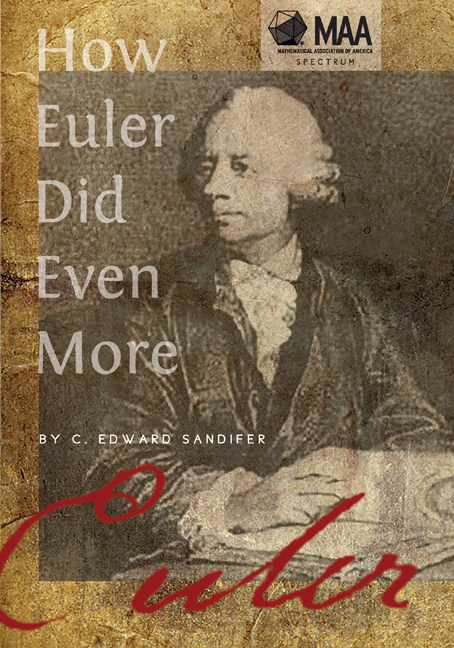Book contents
- Frontmatter
- Contents
- Preface
- Part I Geometry
- 1 The Euler Line (January 2009)
- 2 A Forgotten Fermat Problem (December 2008)
- 3 A Product of Secants (May 2008)
- 4 Curves and Paradox (October 2008)
- 5 Did Euler Prove Cramer's Rule? (November 2009—A Guest Column by Rob Bradley)
- Part II Number Theory
- Part III Combinatorics
- Part IV Analysis
- Part V Applied Mathematics
- Part VI Euleriana
- About the Author
5 - Did Euler Prove Cramer's Rule? (November 2009—A Guest Column by Rob Bradley)
from Part I - Geometry
- Frontmatter
- Contents
- Preface
- Part I Geometry
- 1 The Euler Line (January 2009)
- 2 A Forgotten Fermat Problem (December 2008)
- 3 A Product of Secants (May 2008)
- 4 Curves and Paradox (October 2008)
- 5 Did Euler Prove Cramer's Rule? (November 2009—A Guest Column by Rob Bradley)
- Part II Number Theory
- Part III Combinatorics
- Part IV Analysis
- Part V Applied Mathematics
- Part VI Euleriana
- About the Author
Summary
The 200th anniversary of Euler's death took place in September 1983. The milestone was marked in a reasonable number of publications, although fewer than the number that celebrated the tercentenary of his birth two years ago. The MAA devoted an entire issue of the Mathematics Magazine to Euler's life and work [Vol. 56, no. 4, Nov. 1983] and there were at least two edited volumes of essays published to mark the event.
Among the many essays included in [Burckhardt 1983] is a piece by Pierre Speziali on Euler and Gabriel Cramer (1704—1752), the same Cramer whose name is attached to the famous rule for solving linear systems. Most of Speziali's article is a survey of the correspondence between Euler and Cramer. The Euler-Cramer correspondence will soon be readily available, because it will be included in the forthcoming Volume 7 of Series IVA of Euler's Opera Omnia, scheduled to be published in 2010. Siegfried Bodenmann, a co-editor of IVA.7, discusses the correspondence as an important example of 18th scientific correspondence in his chapter in [Henry 2007].
The correspondence consists of 19 letters in perfect alternation. The first one was a brief letter from Euler, written in 1743. Its contents and tone make it clear that there had previously been no direct contact between the two men. The final letter was written by Euler in late 1751, just a few weeks before Cramer's death. However, the 1975 catalog of Euler's correspondence lists only 17 of these letters. One of the two missing documents was Cramer's final letter to Euler. Although its whereabouts remain a mystery, its contents were known to Speziali and will be included in the Opera Omnia, because Cramer's draft survives in the archives of the public library in Geneva, where Cramer lived and taught. The other missing letter was Euler's third to Cramer. It was written at some point between Cramer's letters of September 30 and November 11, 1744, and was entirely unknown to Speziali in 1983.
- Type
- Chapter
- Information
- How Euler Did Even More , pp. 32 - 38Publisher: Mathematical Association of AmericaPrint publication year: 2014



